Editor of this issue: Antanas Klimas
Copyright © 1983 LITUANUS Foundation, Inc.

|
LITUANUS
LITHUANIAN QUARTERLY JOURNAL OF ARTS AND SCIENCES
Volume 29, No.3 - Fall 1983
Editor of this issue: Antanas Klimas ISSN 0024-5089
Copyright © 1983 LITUANUS Foundation, Inc. |

|
ART SWAYING WITH RHYTHM
RIMA CERKELIUNAS
The paintings of Regina Ingelevicius* are dominated by the rhythm of the line, which reflects the distinctive spiritual mood of her works. Her palette, thickly coated with somber colors, underlines the contemplative character of the canvas, frequently suffused with an atmosphere of grief. She painted in series, compositional challenges always led her to search for new forms of expression. The paintings of individual series very often share the same rhythm, and the lines almost naturally flow from one canvas into another as if part of the same painting.
Already in the earliest works, dating back to the fifties, and executed on the rocky coast of Maine, the artist's philosophy is apparent. All the visible world — the earth, the sky, the people — are only a part of the Whole. The same rhythm and colors pervade not only the cold rocks, but the walking female figures as well. Even the sky reflects the colors of the earth: the browns of the rocks and the blues of the sea.
The artist felt deeply the tragedy of her homeland, Lithuania: flight, exile, a guerilla war back home. All of these she recreated in her paintings. With an almost uninterrupted black line the artist envelopes a group of seated women. The figures wrapped in white, reminiscent of Biblical women, stand out against a crimson sky. The women look anguished but strong, no tragedy is going to destroy them. They represent the eternal women whose plight is centuries old. In another painting, a group of exiled women, one of them with a baby in her arms, are walking past a wooden cross standing by the wayside. The mood is religious; the suffering is meaningful. The colors are dark brown and blue, but here and there flame-like reds shine on the faces, the clothing, and the cross. In a very expressionistic painting of a dying guerilla and his mother, some parts of the bodies are elongated in order to create a mood of horror.
This grim period slowly changes into a happier one, and brighter colors appear in the compositions. With long brush strokes the artist creates colorful compositions that have become more abstract, but even here human figures can be identified. Dark strokes often outline the shapes and give the work an impression of stained glass. These ingeniously composed paintings form an indivisible unity of color and rhythm. The color patterns of the painting entitled "Northern Landscape", which comes closest to being a non-figurative composition, appear to be seen from an airplane. In another work, "In the Artist's Studio", all the pieces of furniture are reduced to near abstractions: the table, the chairs, and the landscape outside the window are felt rather than seen. Similar compositions incorporating human figures outlined by a thick brush stroke are typical for the artist.
Regina Ingelevicius seldom titled her paintings, leaving that to the viewer's imagination. The artist painted mostly oil on canvas or on masonite, but she also has done some interesting expressive work in acrylics.
In her later work, in which landscape paintings predominate, the compositions become less flat, suggesting more depth and space. In some of those works, large trees surround female figures. One perceives the slow movement of the branches. Sunlight breaks through the green leaves, illuminating the earth, the tree trunk and the women. The female figures exude tranquility. The colors of their clothing are rarely different from those of nature; they mostly reflect the browns and greens of the forest. In the same period, the artist frequently painted young girls dressed in native costumes, their heads humbly bowed, their faces contemplative and peaceful, holding doves in their hands. Sometimes these same women, dressed in timeless clothes, are standing near a chapel or under crossed branches symbolizing the house of God.
A similar motif appears in more recent paintings where the same tranquil and composed women are enveloped by a maize of even thicker tree branches, in which the viewer feels a more rapid rhythm, in contrast to the tranquil women's faces which seem unaffected by any external pulsations. These bright paintings vibrate with color and undulating line, where the sun's rays erupt through the entwined branches and leaves tremble in the light wind. The mastering of these more dynamic rhythmic patterns demonstrates not only the artist's technical capabilities but also her innate sensitivity to rhythm.
Regina Ingelevicius's works have been influenced by the Paris School of the early 20th century. In particular, she has a special affinity with the works of the Fauvist Rouault, the reflections of whose creative ideas can be discerned in the artist's canvases. His paintings were saturated with religious mood, wherein thick dark brush lines, like lead moldings of a stained glass, separated one color from another. Regina Ingelevicius interpreted these influences in her own way and developed a unique personal style.
A great number of the artist's works were created by carefully searching for a balance between color and line. However, she has also done a whole series of "impressionistic" paintings, vibrant with radiant colors, demonstrating her ability to spontaneously fix on canvas her experiences, whether the cherry blossoms in the Brooklyn Botanical Garden or the trees resplendent in autumnal colors seen through the window of her house.
Regina Ingelevicius has also painted many portraits, some distinguished by their elaborate and careful characterization, others very spontaneous, as if created with a single brush stroke.
A distinct religious mood pervades Regina Ingelevicius's works. Even her rhythmically dynamic paintings exude a sense of stoic peace. The rhythm in the artist's canvas corresponds to the rhythm of the world, which is neither disturbing nor frantic. It is nature's pulse felt by an artist who speaks of the wholeness of the universe.
* Regina Ingelevičienë (nee Matuzonytë) (1905-1980) was born in Vabalninkas, Lithuania. She studied art at the Art School in Kaunas, graduating in 1931. From 1931 until 1936; she taught art at a high school in Kaunas. In 1936 and 1937, she traveled to France, Germany, and Italy. Since 1931, she has participated in numerous exhibitions. Having arrived in the USA in 1949, she continued painting and participating in many exhibitions. (Ed.)
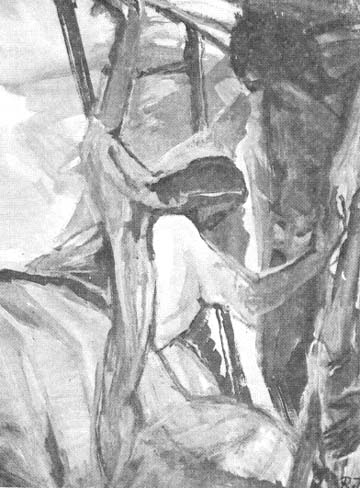
REGINA INGELEVIČIUS, "At the Cross", tempera, 1959-1967, 22x17.
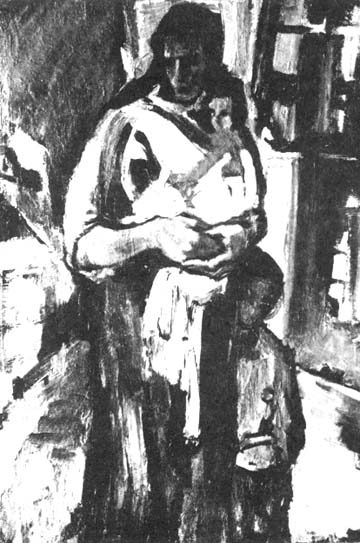
REGINA INGELEVIČlUS, "Mother", oil on canvas, 1954-1962, 24x20.
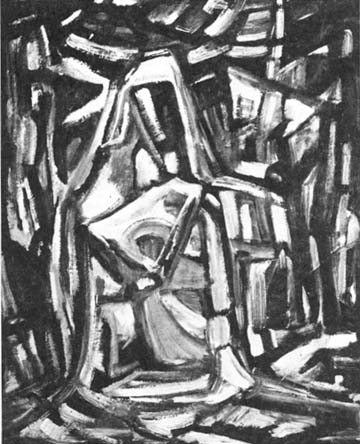
REGINA INGELEVIČlUS, "Mater Dolorosa", oil on paper, 1959-1967, 28x22.
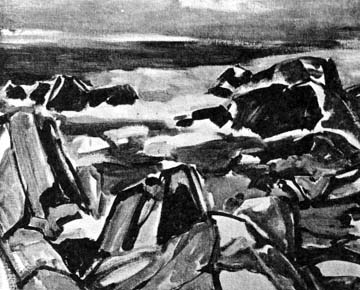
REGINA INGELEVIČIUS, "The Rocks of Maine", oil on canvas, 1970, 16x20.
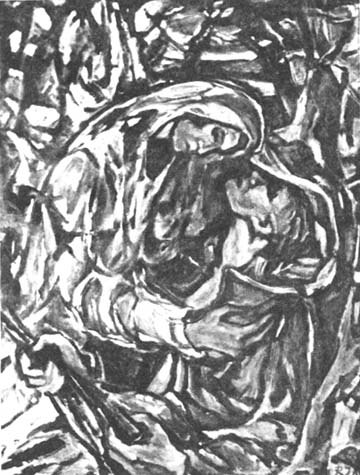
REGINA INGELEVIČIUS, "Death of a freedom fighter", oil on masonite, 1962-1967, 48x36.
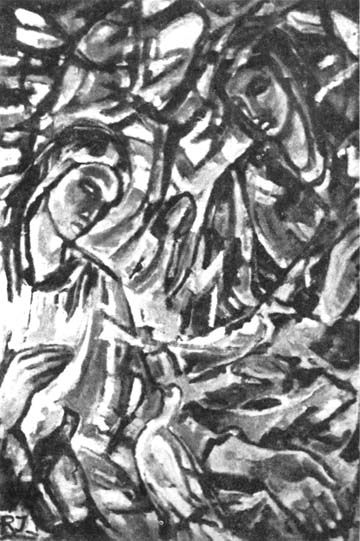
REGINA INGELEVIČlUS "Peace", oil on masonite, 1968-1978, 36x24.